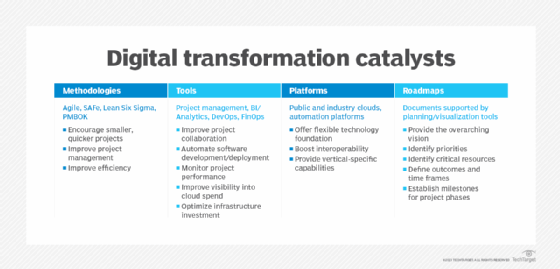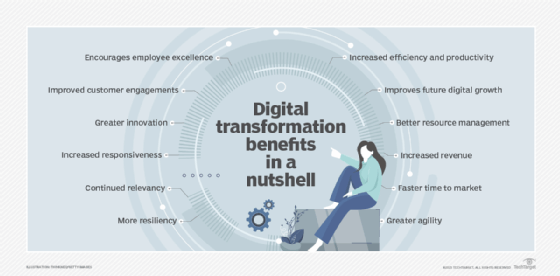digital leadership
What is digital leadership?
Digital leadership is the strategic use of a company's digital assets and emerging technologies to achieve business goals. A digital leader is a person who guides this digital approach within an organization.
Digital leadership is becoming more and more important with the rapidly shifting business landscape and ever-changing technology. Any organization that isn't prepared to assume a digital leadership role can quickly find itself left behind.
To understand the value of digital leadership, consider the rapid changes brought about by the COVID-19 pandemic. No organization expected the rapid societal, business and consumer changes that it caused, causing many businesses to flounder. Organizations with strong digital leadership though, were able to quickly leverage technology to adapt. They were able to efficiently respond to work-from-home mandates and adapt to online-first strategies for customer interaction.
Digital leadership will only become more important. Disruptive technologies are being created every day. The rise of the digital native customer and the rapid development of generative artificial intelligence create new opportunities almost daily. Organizations that can take full advantage of these trends will grow and become future market leaders.
How does digital leadership work?
Digital leadership features the desire and action to proactively use technology to deliver value to an organization. To digital leadership, IT is not a cost center; instead, they know that it's technology that drives the organization forward and proper investment into it will only add value to an organization.
Digital transformation can be a tough process for an organization. Replacing legacy systems and tools has a real financial and personnel cost associated with it. It's an important step though to achieve true digital leadership.
Digital leadership is valuable to any organization, not just traditional tech companies. An excellent example of this is John Deere. They were historically manufacturers of farming equipment, competing on things like features and cost. Recently they have begun to take a digital leadership role in the market. They add recent high-value technology to their products to make the farmer's job easier, such as machine vision, internet of things sensors, fifth generation wireless, also known as 5G, access and digital twin models. This lets a farmer know what is growing and how well, down to the individual plant level. Data models based on climate and weather data provide farmers with real-time predictions and yield estimates.
On their business side, John Deere uses big data and Agile operations to better its internal processes.

Aspects of digital leadership
Digital leadership requires an organizational commitment to change and new ways of thinking and operating. So how it will show will be different in each case. These are some of the aspects that are present in digital leadership organizations.
Training and growth mindset: People are the core of an organization. To attain digital leadership you need to invest in people with training in new technologies. Fostering innovation and growth in employees leads to new ideas that fuel digital innovation.
Data collection and management: Organizations in digital leadership positions recognize the value of data and how to use it. This may require collecting customer and market data and using big data analysis. They find ways to take data and turn it into actionable insights.
Agile organization: Markets and technology are not static. An organization needs to move fast and respond quickly to changing circumstances.
Digital marketing: Digital marketing is often a core part of digital leadership. They know who their customers are and how to reach them.
Information security: Digital leadership requires the use of technology, so securing and protecting that technology needs to be a primary goal, not just an afterthought. Data can be stolen, leaked or corrupted by malicious attackers. Business operations can be disrupted by ransomware, outages, or natural disasters. Strong data governance, data protection, and business continuity plans can help to mitigate these risks.

Who is a digital leader?
Within an organization, a digital leader is someone who promotes the use of technology and helps the entire organization benefit from it. Most often the digital leader is the chief information officer or chief technology officer, but really anyone can become a digital leader by promoting new and novel technology that adds value to an organization.
The digital leader sits at the intersection between business and technology. They understand the organization's strategic objectives and look for ways to use technology to advance them. A good digital leader is constantly asking the question: How can we use technology to make our organization better?
Qualities of a digital leader
Digital leaders should possess several qualities, including the following:
Communication and inspiration: It might not be readily obvious how new technology can help an organization. A digital leader can effectively communicate the potential value of adopting a new technology or being an early adopter. A digital leader helps to get other organization leaders to see the potential benefits and rally them behind a change.
Collaboration: Digital transformations usually involve many people across many teams and work roles. A digital leader needs to be able to unify people from different disciplines. New ideas can come from anywhere, so a digital leader is ready to listen to outside perspectives.
Adaptability: A digital leader needs to be ready to change with every new advance. They aren't committed to any one way to do something, but instead can change to a new way of thinking as needs change.
Technology literacy: A good digital leader does not need to be an expert in every technology. Their main ability is to promote the use of technology to others in an organization and will often rely on subject matter experts for implementation and execution.







